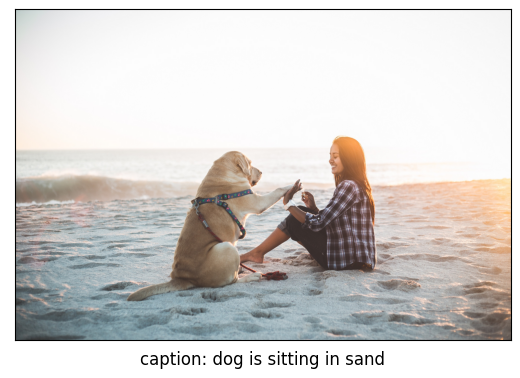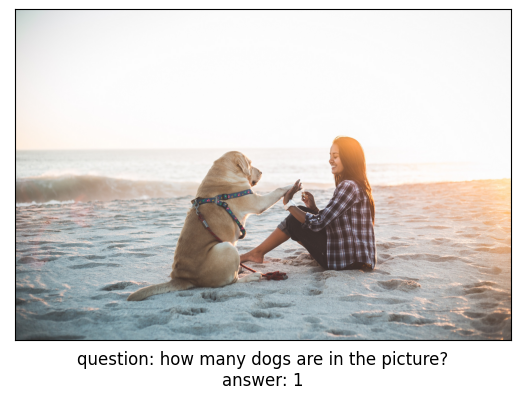Post-Training Quantization and Weights Compression of OpenAI BLIP model with NNCF¶
This Jupyter notebook can be launched after a local installation only.
The goal of this tutorial is to demonstrate how to speed up the model by applying 8-bit post-training quantization and data free int8 weight compression from NNCF (Neural Network Compression Framework) to OpenVINO IR models and infer optimized BLIP model via OpenVINO™ Toolkit. The optimization process contains the following steps:
Download and preprocess dataset for quantization.
Quantize the converted vision and text encoder OpenVINO models from notebook with NNCF.
Compress weights of the OpenVINO text decoder model from notebook with NNCF.
Check the model result using the same input data from the notebook.
Compare model size of converted and optimized models.
Compare performance of converted and optimized models.
NOTE: you should run 233-blip-convert notebook first to generate OpenVINO IR models that are used for optimization.
Table of contents:¶
Prerequisites¶
%pip install -q datasets
from pathlib import Path
VISION_MODEL_OV = Path("blip_vision_model.xml")
TEXT_ENCODER_OV = Path("blip_text_encoder.xml")
TEXT_DECODER_OV = Path("blip_text_decoder_with_past.xml")
if not (VISION_MODEL_OV.exists() and TEXT_ENCODER_OV.exists() and TEXT_DECODER_OV.exists()):
raise RuntimeError('This notebook should be run after 233-blip-convert notebook')
from transformers import BlipProcessor
processor = BlipProcessor.from_pretrained("Salesforce/blip-vqa-base")
Quantize¶
NNCF enables post-training quantization by adding the quantization layers into the model graph and then using a subset of the training dataset to initialize the parameters of these additional quantization layers. The framework is designed so that modifications to your original training code are minor.
The optimization process contains the following steps:
Create a dataset for quantization.
Run
nncf.quantizeto get a quantized model from the pre-trainedFP16model.Serialize the
INT8model usingopenvino.save_modelfunction.
NOTE: Quantization is time and memory consuming operation. Running quantization code below may take some time.
Prepare dataset¶
The VQAv2 is a dataset containing open-ended questions about images. These questions require an understanding of vision, language and commonsense knowledge to answer.
import numpy as np
from datasets import load_dataset
from tqdm.notebook import tqdm
def preprocess_batch(batch, vision_model, inputs_info):
"""
Preprocesses a dataset batch by loading and transforming image and text data.
VQAv2 dataset contains multiple questions to image.
To reduce dataset preparation time we will store preprocessed images in `inputs_info`.
"""
image_id = batch["image_id"]
if image_id in inputs_info:
inputs = processor(text=batch['question'], return_tensors="np")
pixel_values = inputs_info[image_id]["pixel_values"]
encoder_hidden_states = inputs_info[image_id]["encoder_hidden_states"]
else:
inputs = processor(images=batch["image"], text=batch["question"], return_tensors="np")
pixel_values = inputs["pixel_values"]
encoder_hidden_states = vision_model(pixel_values)[vision_model.output(0)]
inputs_info[image_id] = {
"pixel_values": pixel_values,
"encoder_hidden_states": encoder_hidden_states,
"text_encoder_inputs": []
}
text_encoder_inputs = {
"input_ids": inputs["input_ids"],
"attention_mask": inputs["attention_mask"]
}
inputs_info[image_id]["text_encoder_inputs"].append(text_encoder_inputs)
def prepare_input_data(dataloader, vision_model, opt_init_steps):
"""
Store calibration subset in List to reduce quantization time.
"""
inputs_info = {}
for batch in tqdm(dataloader, total=opt_init_steps, desc="Prepare calibration data"):
preprocess_batch(batch, vision_model, inputs_info)
calibration_subset = []
for image_id in inputs_info:
pixel_values = inputs_info[image_id]["pixel_values"]
encoder_hidden_states = inputs_info[image_id]["encoder_hidden_states"]
encoder_attention_mask = np.ones(encoder_hidden_states.shape[:-1], dtype=int)
for text_encoder_inputs in inputs_info[image_id]["text_encoder_inputs"]:
text_encoder_inputs["encoder_hidden_states"] = encoder_hidden_states
text_encoder_inputs["encoder_attention_mask"] = encoder_attention_mask
blip_inputs = {
"vision_model_inputs": {"pixel_values": pixel_values},
"text_encoder_inputs": text_encoder_inputs,
}
calibration_subset.append(blip_inputs)
return calibration_subset
def prepare_dataset(vision_model, opt_init_steps=300, streaming=True):
"""
Prepares a vision-text dataset for quantization.
"""
dataset = load_dataset("HuggingFaceM4/VQAv2", split="train", streaming=streaming)
train_dataset = dataset.shuffle(seed=42).take(opt_init_steps)
calibration_subset = prepare_input_data(train_dataset, vision_model, opt_init_steps)
return calibration_subset
Loading and processing the dataset in streaming mode may take a long time and depends on your internet connection.
import nncf
import openvino as ov
comp_vision_model = ov.compile_model(VISION_MODEL_OV)
calibration_data = prepare_dataset(comp_vision_model)
INFO:nncf:NNCF initialized successfully. Supported frameworks detected: torch, tensorflow, onnx, openvino
Repo card metadata block was not found. Setting CardData to empty.
Prepare calibration data: 0%| | 0/300 [00:00<?, ?it/s]
Vision model¶
VISION_MODEL_OV_INT8 = Path(str(VISION_MODEL_OV).replace(".xml", "_int8.xml"))
core = ov.Core()
ov_vision_model = core.read_model(VISION_MODEL_OV)
vision_dataset = nncf.Dataset(calibration_data, lambda x: x["vision_model_inputs"])
quantized_model = nncf.quantize(
model=ov_vision_model,
calibration_dataset=vision_dataset,
model_type=nncf.ModelType.TRANSFORMER
)
ov.save_model(quantized_model, VISION_MODEL_OV_INT8)
Statistics collection: 100%|██████████| 300/300 [00:21<00:00, 14.06it/s]
Applying Smooth Quant: 100%|██████████| 48/48 [00:01<00:00, 29.72it/s]
INFO:nncf:36 ignored nodes was found by name in the NNCFGraph
Statistics collection: 100%|██████████| 300/300 [01:17<00:00, 3.89it/s]
Applying Fast Bias correction: 100%|██████████| 49/49 [00:27<00:00, 1.80it/s]
Text encoder¶
TEXT_ENCODER_OV_INT8 = Path(str(TEXT_ENCODER_OV).replace(".xml", "_int8.xml"))
text_encoder_dataset = nncf.Dataset(calibration_data, lambda x: x["text_encoder_inputs"])
ov_text_encoder = core.read_model(TEXT_ENCODER_OV)
quantized_model = nncf.quantize(
model=ov_text_encoder,
calibration_dataset=text_encoder_dataset,
model_type=nncf.ModelType.TRANSFORMER
)
ov.save_model(quantized_model, TEXT_ENCODER_OV_INT8)
Statistics collection: 100%|██████████| 300/300 [00:10<00:00, 28.70it/s]
Applying Smooth Quant: 100%|██████████| 73/73 [00:02<00:00, 28.87it/s]
INFO:nncf:72 ignored nodes was found by name in the NNCFGraph
Statistics collection: 100%|██████████| 300/300 [00:31<00:00, 9.54it/s]
Applying Fast Bias correction: 100%|██████████| 120/120 [00:38<00:00, 3.11it/s]
Compress weights¶
The quantization of the text decoder leads to significant accuracy loss. Instead of post-training quantization, we can use data free weights compression to reduce the model footprint.
The optimization process contains the following steps:
Run
nncf.compress_weightsto get a model with compressed weights.Serialize the
OpenVINOmodel usingopenvino.save_modelfunction.
TEXT_DECODER_OV_INT8 = Path(str(TEXT_DECODER_OV).replace(".xml", "_int8.xml"))
text_decoder = core.read_model(TEXT_DECODER_OV)
compressed_text_decoder = nncf.compress_weights(text_decoder)
ov.save_model(compressed_text_decoder, str(TEXT_DECODER_OV_INT8))
Run optimized OpenVINO model¶
The steps for making predictions with the optimized OpenVINO BLIP model are similar to the PyTorch model. Let us check the model result using the same input data from the first notebook.
q_ov_vision_model = ov.compile_model(VISION_MODEL_OV_INT8)
q_ov_text_encoder = ov.compile_model(TEXT_ENCODER_OV_INT8)
q_ov_text_decoder_with_past = ov.compile_model(TEXT_DECODER_OV_INT8)
from functools import partial
from transformers import BlipForQuestionAnswering
from blip_model import OVBlipModel, text_decoder_forward
model = BlipForQuestionAnswering.from_pretrained("Salesforce/blip-vqa-base")
text_decoder = model.text_decoder
text_decoder.eval()
text_decoder.forward = partial(text_decoder_forward, ov_text_decoder_with_past=q_ov_text_decoder_with_past)
int8_model = OVBlipModel(model.config, model.decoder_start_token_id, q_ov_vision_model, q_ov_text_encoder, text_decoder)
from PIL import Image
raw_image = Image.open("demo.jpg").convert('RGB')
question = "how many dogs are in the picture?"
# preprocess input data
inputs = processor(raw_image, question, return_tensors="pt")
Image Captioning¶
from utils import visualize_results
out = int8_model.generate_caption(inputs["pixel_values"], max_length=20)
caption = processor.decode(out[0], skip_special_tokens=True)
fig = visualize_results(raw_image, caption)

Question Answering¶
out = int8_model.generate_answer(**inputs, max_length=20)
answer = processor.decode(out[0], skip_special_tokens=True)
fig = visualize_results(raw_image, answer, question)

Compare file sizes¶
def calculate_compression_rate(ov_model_path):
fp16_ir_model_size = Path(ov_model_path).with_suffix(".bin").stat().st_size / 1024
int8_model_path = str(ov_model_path).replace(".xml", "_int8.xml")
quantized_model_size = Path(int8_model_path).with_suffix(".bin").stat().st_size / 1024
print(f'{ov_model_path.as_posix().split(".")[0]}')
print(f" * FP16 IR model size: {fp16_ir_model_size:.2f} KB")
print(f" * INT8 model size: {quantized_model_size:.2f} KB")
print(f" * Model compression rate: {fp16_ir_model_size / quantized_model_size:.3f}")
for model_path in [VISION_MODEL_OV, TEXT_ENCODER_OV, TEXT_DECODER_OV]:
calculate_compression_rate(model_path)
blip_vision_model
* FP16 IR model size: 168145.68 KB
* INT8 model size: 84915.75 KB
* Model compression rate: 1.980
blip_text_encoder
* FP16 IR model size: 268087.17 KB
* INT8 model size: 134677.23 KB
* Model compression rate: 1.991
blip_text_decoder_with_past
* FP16 IR model size: 269303.42 KB
* INT8 model size: 135450.65 KB
* Model compression rate: 1.988
Compare inference time of the FP16 and optimized models¶
To measure the inference performance of the FP16 and INT8
models, we use median inference time on 100 samples of the calibration
dataset. So we can approximately estimate the speed up of the dynamic
quantized models.
NOTE: For the most accurate performance estimation, it is recommended to run
benchmark_appin a terminal/command prompt after closing other applications with static shapes.
import time
import torch
def calculate_inference_time(blip_model, calibration_data, generate_caption):
inference_time = []
for inputs in calibration_data:
pixel_values = torch.from_numpy(inputs["vision_model_inputs"]["pixel_values"])
input_ids = torch.from_numpy(inputs["text_encoder_inputs"]["input_ids"])
attention_mask = torch.from_numpy(inputs["text_encoder_inputs"]["attention_mask"])
start = time.perf_counter()
if generate_caption:
_ = blip_model.generate_caption(pixel_values, max_length=20)
else:
_ = blip_model.generate_answer(pixel_values=pixel_values, input_ids=input_ids, attention_mask=attention_mask, max_length=20)
end = time.perf_counter()
delta = end - start
inference_time.append(delta)
return np.median(inference_time)
fp_original_model = BlipForQuestionAnswering.from_pretrained("Salesforce/blip-vqa-base")
fp_text_decoder = fp_original_model.text_decoder
fp_text_decoder.eval()
comp_text_encoder = ov.compile_model(TEXT_ENCODER_OV)
comp_text_decoder_with_past = ov.compile_model(TEXT_DECODER_OV)
fp_text_decoder.forward = partial(text_decoder_forward, ov_text_decoder_with_past=comp_text_decoder_with_past)
fp16_model = OVBlipModel(model.config, model.decoder_start_token_id, comp_vision_model, comp_text_encoder, fp_text_decoder)
validation_data = calibration_data[:100]
int8_caption_latency = calculate_inference_time(int8_model, validation_data, generate_caption=True)
fp16_caption_latency = calculate_inference_time(fp16_model, validation_data, generate_caption=True)
print(f"Image Captioning speed up: {fp16_caption_latency / int8_caption_latency:.3f}")
int8_generate_answer_latency = calculate_inference_time(int8_model, validation_data, generate_caption=False)
fp16_generate_answer_latency = calculate_inference_time(fp16_model, validation_data, generate_caption=False)
print(f"Question Answering speed up: {fp16_generate_answer_latency / int8_generate_answer_latency:.3f}")